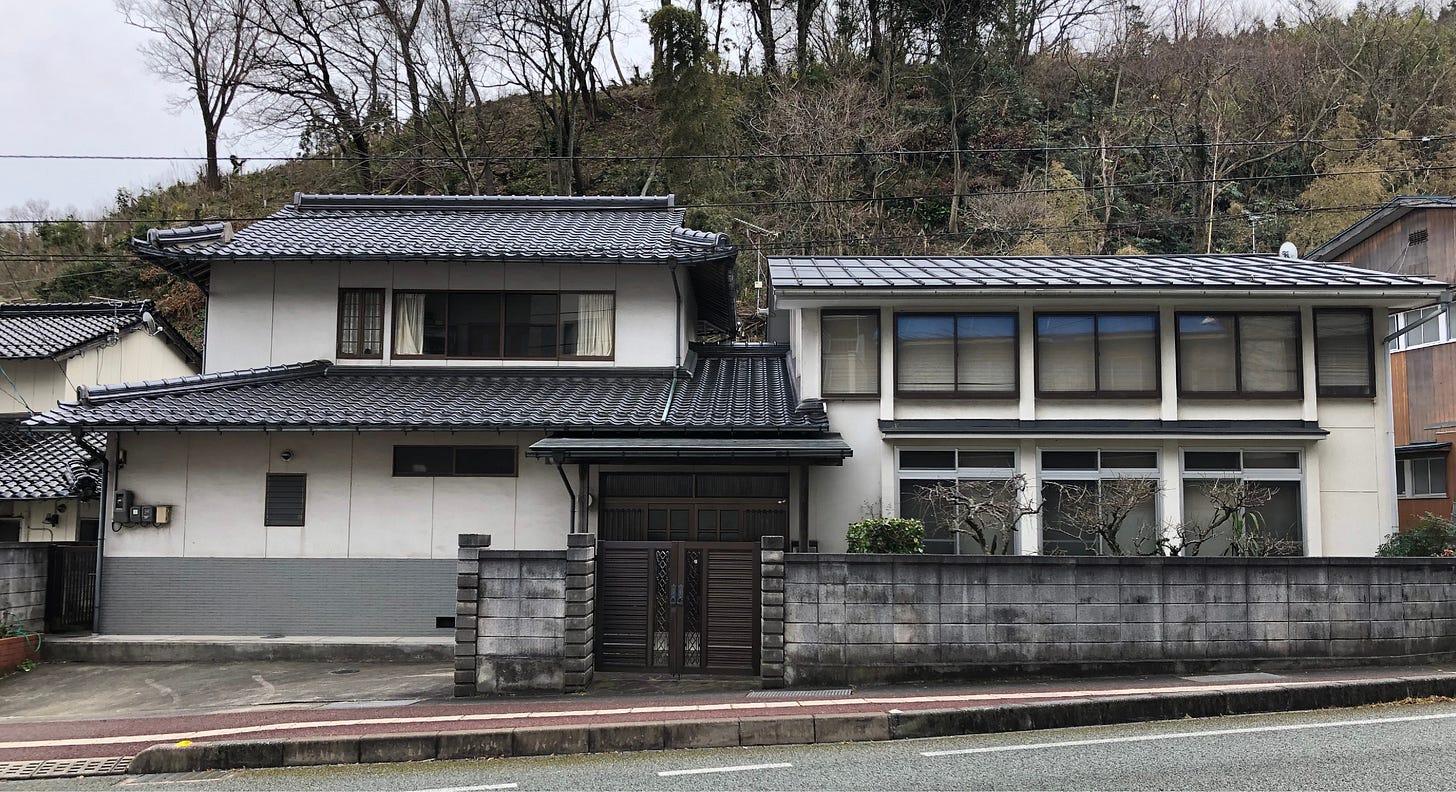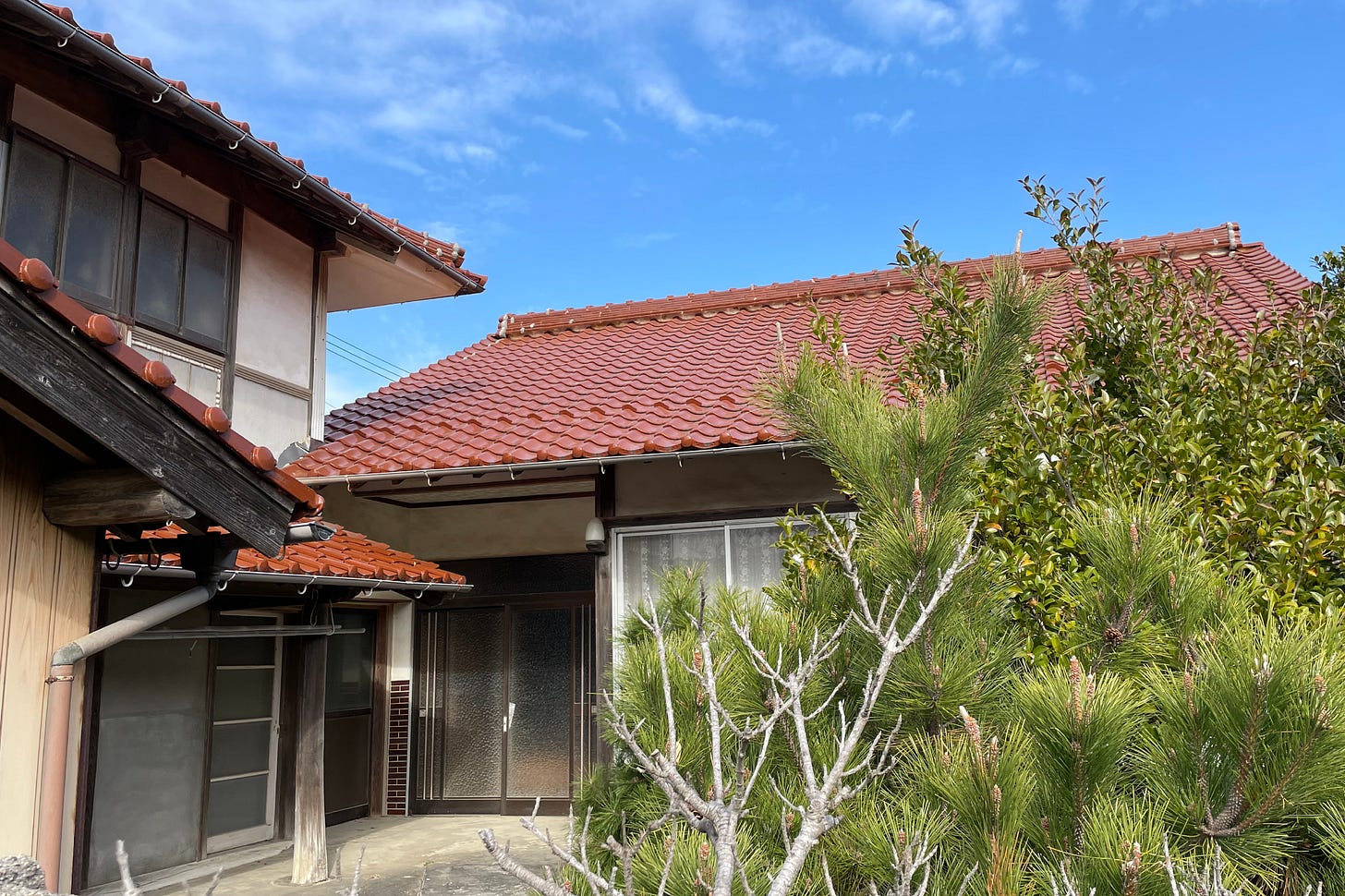Akiya are Everywhere
A glimpse into my house auditions
“Akiya are everywhere!” I hear this often when I tell people that I want to turn one into a performance piece. They are a “problem” so pervasive in Japan that the reactions I get are inevitably loaded with the experiences and thoughts of the person in front of me. The word “akiya” can call to mind a romantic vision of the past when families gathered around fires to eat. But it is equally as likely to call to mind elderly grandmothers living alone and using plastic grab bars in pink-tiled bathrooms. Mud walls and hand-hewn roof beams inspire some people to envision a café filled with urbanites sipping sustainably sourced coffee, while others see dangerously loose roof tiles and land that would be worth more as a parking lot. There is truth in all of these visions and for that reason the first step of choosing a house for my project has not been a simple matter of just finding one that is cheap. More than anything it has been about seeing and understanding the reactions these houses conjure up in me and those around me.
This house is in a former silver mining town and UNESCO World Heritage Site that is about an hour’s drive from us. It is for rent for less than $300 a month and was built in 1876. It does not feel like it has changed much since then, although the kitchen and bathroom are more recent. The town often appears on tv, projecting an idyllic image of itself as a place where young children can grow up in a nostalgic vision of rural Japan that is carefully and deliberately being restored and preserved. Concrete facades have been peeled away and modern necessities like air conditioners and vending machines have been camouflaged. The main pedestrian-friendly street is lined with chic cafes and shops, in addition to a beautiful new nursery school and library.
After hearing about my project, a friend in America told me about her family’s home in a tiny town in the mountains about forty minutes away from us. She has fond memories of staying there as a girl during World War II. Her story is fascinating, and I hope she might let me tell it at some point. Although the house is empty now, I could see it through her eyes as a magical, lively refuge where guests came to visit and water from a mountain stream was collected from a bamboo spout in the back yard. The family has made the calculus that it is not worth the money to make repairs. They are selling what they can to antique dealers and like so many others, deciding what to do with a property no one wants to live in anymore.
Some people ask me why I don’t use my own family home for my project. I agree that it is the most obvious, logical, and economic choice. Not only would it cut my commuting time to zero, the anxiety I felt about the objects contained in the house was the impetus for my project, after all. Over the past five years Andy and I have been cataloguing my grandfather and grandmother’s paintings, cross-referencing them with exhibition catalogues and trying to organize them. There are over a thousand, not including un-stretched canvases and sketchbooks, as well as paintings that are hanging in public and private collections across the prefecture. Theatre is often about conflict, and certainly at times it feels as though the house and I are fighting each other. I do eventually want to examine how the East and the West connect in my grandfather’s Western-style oil paintings and my own journey as an artist from America to Japan, but I worry that tackling this now would end up devouring my Ichi Oku House Project. A separate house could be a stand-in for my family home, the one step of removal hopefully allowing me to see my own situation with some lightness and giving me some clarity before I embark on this other project.
Another reaction that I frequently hear when I explain my project to people is, “You should do your project in [insert-name-of-more stylish/lively-town]!” But my friend, Yuki, has been the only person who has said from the beginning, “You should do your project HERE!” “Here” is an unassuming but charming beach community with old red-tile-roof buildings that is about twenty minutes from our house, and even closer to the grape farm where Andy and I sometimes work. Yuki and her husband found their own house through the akiya bank. They went on to buy the house next door as well, turning it into a guest house and English language center. Together we have walked from one end of the village to the other, looking at different akiya and meeting neighbors who are in the process of renovating their own. The one that has interested me the most was built in 1910 and is selling for less than $19,000. The kitchen and bathroom have been modernized, but it lacks heating and air conditioning and has not been connected to the city’s new sewage system. I submitted paperwork in April to try to pursue this option, but my forward momentum has been ground to a halt by Japanese bureaucracy and I am beginning to see the hidden costs of buying and repairing an akiya. The owner is hoping to add some farmland, a mountain, and a pond as part of the deal for no extra cost, a perfect illustration that property ownership is more of a liability than an asset in rural Japan.
The process that I thought was linear, where I was tempering my fantasies and quieting my fears to whittle my way down to a decision, has not been so linear after all. I am re-considering options that are not even included in this list, reminding myself that there is no right decision and there is no wrong decision. Perhaps it is good that I am heading back to the states for a few weeks, going first to the Boston-area and then to New York. The change of perspective might be helpful. But ultimately, I know that whatever space I choose will work just fine for my Ichi Oku House Project. Akiya are everywhere.
If you’d like to watch presentations from me and over 40 other grantees about our in-progress Creative Capital projects in the Performing Arts, Literature, and Technology, the online premiere of Creative Capital’s Carnival Artist Project Screening will be on YouTube, June 22, 2023 at 1PM ET—please register here.









